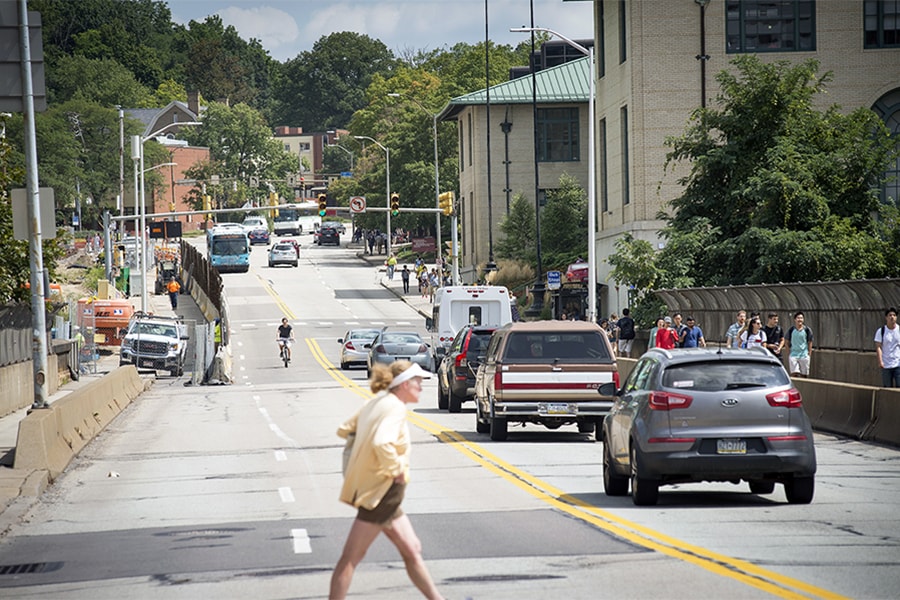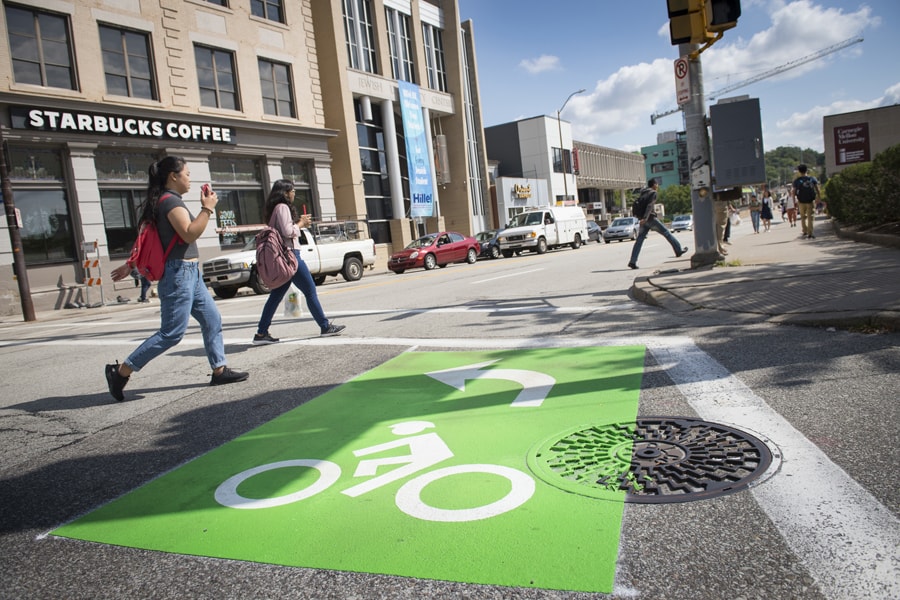
Forbes Avenue Project: “Once in a Generation Opportunity for CMU”
By Bruce Gerson
The Forbes Avenue Corridor Improvement Project took a major step forward this past summer when CMU and PennDOT held its second public meeting on work that will benefit pedestrians, bicyclists, motorists and public transit riders.
“The Forbes Avenue enhancement project never would have occurred without the innovative thinking of Carnegie Mellon University,” said Cheryl Moon-Sirianni, PennDOT assistant district executive for design. “The partnership with CMU allowed PennDOT to stretch the transportation dollars for this corridor and make vital multimodal infrastructure improvements that will enhance safety for all users.”
Rodney McClendon, CMU vice president for Operations, commended PennDOT for putting safety first.
"Forbes Avenue is an extremely busy corridor through our campus, and at times it can be dangerous. Making modifications and adding measures to increase safety for everyone is something that is greatly needed," McClendon said.
Pittsburgh City Councilman Dan Gilman, a CMU alumnus, also praised the safety features of the plan.
“This project should make an incredible improvement for the safety of students, faculty and staff, and the city,” Gilman said. “It will help all modes of transportation.”
In addition to the safety and transportation benefits, Ralph Horgan, associate vice president for Campus Design and Facility Development, said the work will help to integrate university developments in the Forbes corridor.
“Forbes Avenue will become a beautiful and safe university gateway that will connect the Cohon University Center and the Cut with the new Tepper Quad, Hamburg Hall and the upcoming Tata Consultancy Services building,” Horgan said. ”This project will tie it all together, enriching CMU, Oakland and the city of Pittsburgh.”
Bob Reppe, director of design for CDFD, called the project a “once in a generation opportunity for CMU.”
Motorists will see new technology-enhanced, adaptive traffic signals and dedicated turning lanes to help regulate traffic flow. The existing light at Hamburg Hall will be moved east to Cyert Drive, and a new intersection with turning lanes will be added at the new Tepper Quad location, opposite the Collaborative Innovation Center Drive.
For pedestrians, countdown timers and audible signals for the visually impaired will be installed at pedestrian crossings. The crossings will have American Disabilities Act compliant curb ramps and will be painted with highly visible “piano key” crosswalks. Planting strips between the curb and roadway will be added for pedestrian safety.

In the two-stage left turn system, bicyclists will travel straight through the intersection to a staging area, where they will wait for the light to cross and complete the turn.
Bicyclists will have 5-foot-wide bicycle lanes in each direction and new signage and road markings for bicycles between South Craig and Beeler Street. Two-stage left turns for bicycles will be employed to increase safety. In the two-stage left turn system, bicyclists will travel straight through the intersection to a designated staging area, where they will then wait for the green light to cross the intersection and complete the turn.
“Pull offs” or curb “bump outs” will be created to give buses room to pull over to pick up and drop off passengers making easier access and egress for transit riders and enabling better traffic flow.
Scott Bricker, executive director of Bike Pittsburgh, praised the revisions made since the first public meeting in August 2016. Among them were the inclusion of the two-stage left turn for bicyclists and widening of the bike lanes.
“I am really pleased to see how the project team has listened to the community to make the project better,” said Bricker, a 1999 CMU alumnus. “It’s utilizing the latest and greatest in terms of intersection design, turning movements for cyclists and pedestrian facilities.”
Bricker said the two-stage left turn for bicyclists was introduced in Copenhagen and is being used in a number of cities.
“It’s a lot safer,” he said. “It’s part of the National Association for City Transportation Officials guidebook for bikeway design.”
Mary Shaw, the A.J. Perlis University Professor and an avid cyclist, said she was happy with the project team’s work.
“I think they’ve done a lot more work and have been a lot more responsive,” she said. “The planning for pedestrians and bicyclists has certainly been better integrated into the plan.”
Moon-Sirianni said the project would be open to contractors for bidding this fall. Work will begin in early 2018 and will be completed in late fall 2018. The selected contractor will hold public meetings prior to the start of construction.
